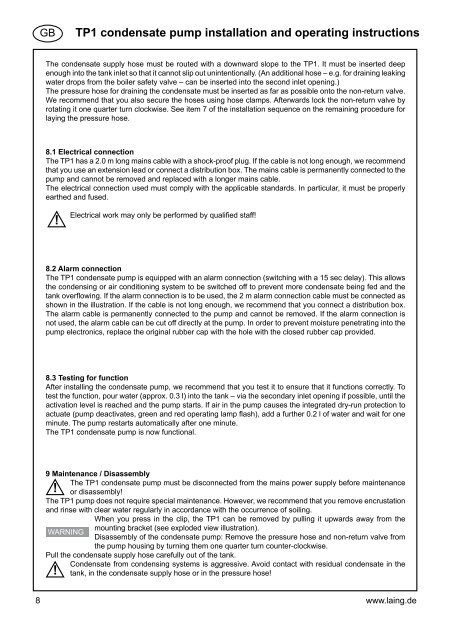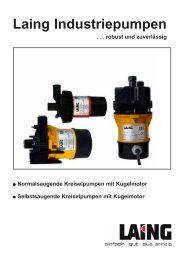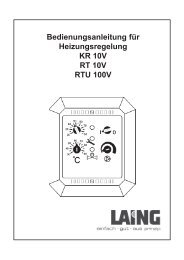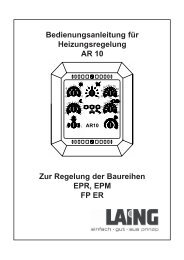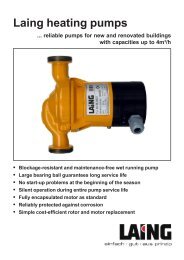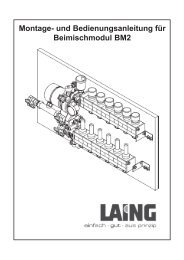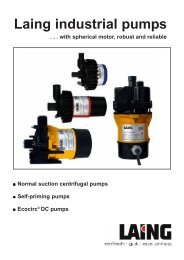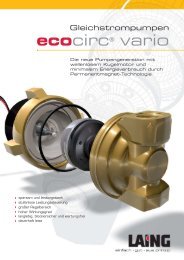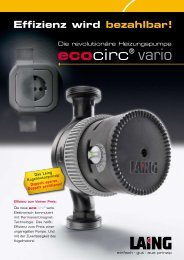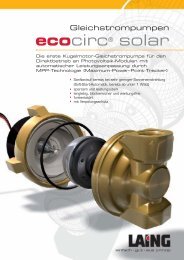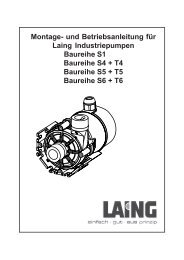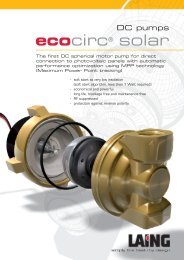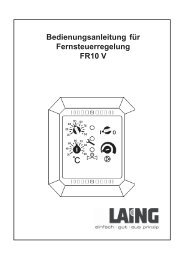Montage- und Bedienungsanleitung Kondensatpumpe ... - LAING.cz
Montage- und Bedienungsanleitung Kondensatpumpe ... - LAING.cz
Montage- und Bedienungsanleitung Kondensatpumpe ... - LAING.cz
You also want an ePaper? Increase the reach of your titles
YUMPU automatically turns print PDFs into web optimized ePapers that Google loves.
GB<br />
TP1 condensate pump installation and operating instructions<br />
The condensate supply hose must be routed with a downward slope to the TP1. It must be inserted deep<br />
enough into the tank inlet so that it cannot slip out unintentionally. (An additional hose – e.g. for draining leaking<br />
water drops from the boiler safety valve – can be inserted into the second inlet opening.)<br />
The pressure hose for draining the condensate must be inserted as far as possible onto the non-return valve.<br />
We recommend that you also secure the hoses using hose clamps. Afterwards lock the non-return valve by<br />
rotating it one quarter turn clockwise. See item 7 of the installation sequence on the remaining procedure for<br />
laying the pressure hose.<br />
8.1 Electrical connection<br />
The TP1 has a 2.0 m long mains cable with a shock-proof plug. If the cable is not long enough, we recommend<br />
that you use an extension lead or connect a distribution box. The mains cable is permanently connected to the<br />
pump and cannot be removed and replaced with a longer mains cable.<br />
The electrical connection used must comply with the applicable standards. In particular, it must be properly<br />
earthed and fused.<br />
!<br />
Electrical work may only be performed by qualified staff!<br />
8.2 Alarm connection<br />
The TP1 condensate pump is equipped with an alarm connection (switching with a 15 sec delay). This allows<br />
the condensing or air conditioning system to be switched off to prevent more condensate being fed and the<br />
tank overflowing. If the alarm connection is to be used, the 2 m alarm connection cable must be connected as<br />
shown in the illustration. If the cable is not long enough, we recommend that you connect a distribution box.<br />
The alarm cable is permanently connected to the pump and cannot be removed. If the alarm connection is<br />
not used, the alarm cable can be cut off directly at the pump. In order to prevent moisture penetrating into the<br />
pump electronics, replace the original rubber cap with the hole with the closed rubber cap provided.<br />
8.3 Testing for function<br />
After installing the condensate pump, we recommend that you test it to ensure that it functions correctly. To<br />
test the function, pour water (approx. 0.3 l) into the tank – via the secondary inlet opening if possible, until the<br />
activation level is reached and the pump starts. If air in the pump causes the integrated dry-run protection to<br />
actuate (pump deactivates, green and red operating lamp flash), add a further 0.2 l of water and wait for one<br />
minute. The pump restarts automatically after one minute.<br />
The TP1 condensate pump is now functional.<br />
9 Maintenance / Disassembly<br />
The TP1 condensate pump must be disconnected from the mains power supply before maintenance<br />
! or disassembly!<br />
The TP1 pump does not require special maintenance. However, we recommend that you remove encrustation<br />
and rinse with clear water regularly in accordance with the occurrence of soiling.<br />
When you press in the clip, the TP1 can be removed by pulling it upwards away from the<br />
mounting bracket (see exploded view illustration).<br />
WARNING<br />
Disassembly of the condensate pump: Remove the pressure hose and non-return valve from<br />
the pump housing by turning them one quarter turn counter-clockwise.<br />
Pull the condensate supply hose carefully out of the tank.<br />
Condensate from condensing systems is aggressive. Avoid contact with residual condensate in the<br />
tank, in the condensate supply hose or in the pressure hose!<br />
!<br />
<br />
www.laing.de


